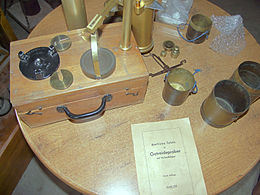Bulk density
As bulk density ρ Sch ( English bulk density or poured density ), colloquially also "bulk density", one describes the density , i. H. the mass per volume , a mixture of a granular solid (" bulk material ") and a continuous fluid that fills the voids between the particles . The fluid can also be air. The individual components must not become detached from one another .
The bulk density is similar, but not identical, to the specific weight , which indicates the weight force per volume.
On the bulk density, a distinction tapped density (English tapped density ) and density (English also bulk density ).
definition
The bulk density is defined analogously to the density of gases, liquids and solids as the ratio of the mass of the bulk to the bulk volume taken up :
The derived SI unit of bulk density is kilograms per cubic meter :
For a mixture consisting of components :
In the case of mixing a solid ( ) with a gas ( ), the bulk density can also be determined by taking the porosity into account :
If the porosity is less than 0.98 and the gas is present at moderate pressures ( ), the summand can be neglected:
Grain density
In DIN EN ISO 17892-3 (formerly DIN 18124) the grain density is defined as a soil mechanical parameter . It is determined by drying the substance at 105 ° C., weighing it and then measuring the displacement volume in a measuring liquid; the substance must be insoluble in the measuring liquid. The grain density is - as shown above - the ratio of dry matter to displacement volume:
and, like the true density, is given in kg / m³. As a test device z. B. used a capillary pycnometer.
Hectolitre mass
| Type | Grain | Hectolitre mass |
|---|---|---|
| Heavy grain | Bread wheat | 72-82 kg / hl |
| rye | 70-75 kg / hl | |
| Feed wheat | 65-71 kg / hl | |
| Light grain | barley | 60-65 kg / hl |
| oats | 45-50 kg / hl | |
| Cereal product | wheat flour | 50-55 kg / hl |
| Rye meal | approx. 50 kg / hl |
In warehouses and mills for grain as well as in all food processing plants in which grain, grain products or flour-like products are processed, the terms hectolitre mass (formerly hectolitre weight ) or natural weight (physically correct would be natural mass ) are used instead of the bulk density , in each case in the unit of measurement kg / hl .
The hectolitre mass of grain is determined with grain samples that have a volume of ¼ l, 1 l or 20 l. These are filled and the mass is determined using a scale.
The values of the 20 l probes are used as a reference , they only have to be extrapolated with a factor of 5 to 1 hl = 100 l:
However, if the bulk density is determined with a 1/4 l or a 1 l prober, the values must then be corrected using "official tables", since the bulk density also depends on the volume of the prober (!):
The hectolitre mass is determined in order to know the need for storage space in the silo , if z. B. Grain batches are to be stored. A reliable statement about the grain quality based on the hectolitre mass can not be made, since the hectolitre mass depends on many different factors (grain shape, moisture , pollution , etc.). In terms of the tendency, a higher hectolitre mass promises better quality.
Since grain is a natural product , the values can fluctuate more than indicated above depending on the harvesting conditions .
See also
Web links
- Determination of bulk density (PDF file; 47 kB)
- Comprehensive table of typical bulk densities
literature
- Matthias Stieß: Mechanical Process Engineering - Particle Technology 1st 3rd edition, Springer Verlag, Berlin 2007, ISBN 3-540-32551-4




![\ left [\ rho _ {{\ mathrm {Sch}}} \ right] = {\ mathrm {{\ frac {kg} {m ^ {3}}}}}](https://wikimedia.org/api/rest_v1/media/math/render/svg/ae0f768265527c768f977e28c9a1f88d0c7d5432)



















